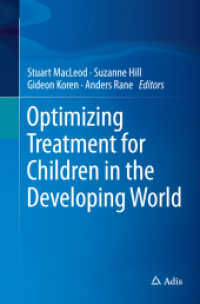- ホーム
- > 洋書
- > 英文書
- > Psychology
Full Description
A wide range of research explores patterns of lateralisation for processing emotion. Yet, relatively little explores how emotion lateralisation changes across the lifespan. This special issue addresses this gap in our understanding, focusing on what might influence the development of laterality for emotion processing, how links between lateralisation for emotion processing may be related to an individual's emotion recognition performance, how lateralisation for emotion processing may explain social deficits in clinical populations, and if patterns of lateralisation might be dependent on one's life experiences.
Importantly, the papers in this special issue explore variability in lateralisation at differing time points from infancy to old age. They employ a wide range of methods to explore these changes in emotion lateralisation, such as behavioural measures and electrophysiological methods. The varying approaches allow for a broad exploration of the development of lateralisation for emotion processing from infancy through childhood, changes through adulthood and into older age, and considers the relationship between the neuropsychological processing of emotional stimuli, behavioural emotional processing, and social interactions. The empirical work presented in this issue provides a number of unique contributions to the understanding of the relationship between emotion lateralisation and behaviour, with the review paper bringing together our current understanding with these new insights for the development of emotion lateralisation.
Contents
1. Emotion lateralisation: Developments throughout the lifespan D. Watling, L. Workman and V.J. Bourne 2. Holding-side influences on infant's view of mother's face A.W. Hendriks, M. van Rijswijk and D. Omtzigt 3. Preschool child and adult lateralization and performance in emotion and language tasks J.M. Barth, D.B. Boles, A.A. Giattina and C.E. Penn 4. Abnormal patterns of cerebral lateralisation as revealed by the universal chimeric faces task in individuals with autistic disorder S. Taylor, L. Workman and H. Yeomans 5. Strength of lateralization for processing facial emotion in relation to autistic traits in individuals without autism M. Vladeanu, E.M. Monteith-Hodge and V.J. Bourne 6. Hemispheric processing of differently-valenced and self-relevant attachment words in middle-aged married and separated individuals N. Fussell, A. Rowe and C. Mohr 7. Processing emotion from the eyes: A divided visual field and ERP study A.B. Beaton, N.C. Fouquet, N.C. Maycock, E. Platt, L.S. Payne and A. Derrett








